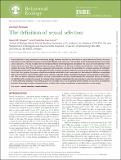Files in this item
The definition of sexual selection
Item metadata
| dc.contributor.author | Shuker, David M | |
| dc.contributor.author | Kvarnemo, Charlotta | |
| dc.date.accessioned | 2021-08-24T15:30:16Z | |
| dc.date.available | 2021-08-24T15:30:16Z | |
| dc.date.issued | 2021-08-07 | |
| dc.identifier | 275589373 | |
| dc.identifier | b620e083-7f12-48a0-aada-df9b50551874 | |
| dc.identifier | 85116185981 | |
| dc.identifier | 000713795600001 | |
| dc.identifier.citation | Shuker , D M & Kvarnemo , C 2021 , ' The definition of sexual selection ' , Behavioral Ecology , vol. Advance Article . https://doi.org/10.1093/beheco/arab055 | en |
| dc.identifier.issn | 1045-2249 | |
| dc.identifier.other | Bibtex: 10.1093/beheco/arab055 | |
| dc.identifier.uri | https://hdl.handle.net/10023/23824 | |
| dc.description | The work was supported by Vetenskapsrådet (2020-04992) to C.K. | en |
| dc.description.abstract | Sexual selection is a key component of evolutionary biology. However, from the very formulation of sexual selection by Darwin, the nature and extent of sexual selection have been controversial. Recently, such controversy has led back to the fundamental question of just what sexual selection is. This has included how we incorporate female-female reproductive competition into sexual or natural selection. In this review, we do four things. First, we examine what we want a definition to do. Second, we define sexual selection: sexual selection is any selection that arises from fitness differences associated with nonrandom success in the competition for access to gametes for fertilization. An important outcome of this is that as mates often also offer access to resources, when those resources are the targets of the competition, rather than their gametes, the process should be considered natural rather than sexual selection. We believe this definition encapsulates both much of Darwin’s original thinking about sexual selection, and much of how contemporary biologists use the concept of sexual selection. Third, we address alternative definitions, focusing in some detail on the role of female reproductive competition. Fourth, we challenge our definition with a number of scenarios, for instance where natural and sexual selection may align (as in some forms of endurance rivalry), or where differential allocation means teasing apart how fecundity and access to gametes influence fitness. In conclusion, we emphasize that whilst the ecological realities of sexual selection are likely to be complex, the definition of sexual selection is rather simple. | |
| dc.format.extent | 14 | |
| dc.format.extent | 516295 | |
| dc.language.iso | eng | |
| dc.relation.ispartof | Behavioral Ecology | en |
| dc.subject | Natural selection | en |
| dc.subject | Sexual selection | en |
| dc.subject | QH Natural history | en |
| dc.subject | 3rd-DAS | en |
| dc.subject.lcc | QH | en |
| dc.title | The definition of sexual selection | en |
| dc.type | Journal article | en |
| dc.contributor.institution | University of St Andrews. School of Biology | en |
| dc.contributor.institution | University of St Andrews. Centre for Biological Diversity | en |
| dc.contributor.institution | University of St Andrews. Scottish Oceans Institute | en |
| dc.contributor.institution | University of St Andrews. Institute of Behavioural and Neural Sciences | en |
| dc.identifier.doi | https://doi.org/10.1093/beheco/arab055 | |
| dc.description.status | Peer reviewed | en |
This item appears in the following Collection(s)
Items in the St Andrews Research Repository are protected by copyright, with all rights reserved, unless otherwise indicated.

